Guan Gui
College of Telecommunications and Information Engineering, Nanjing University of Posts and Telecommunications
\emph{FoQuS}: A Forgetting-Quality Coreset Selection Framework for Automatic Modulation Recognition
Sep 10, 2025Abstract:Deep learning-based Automatic Modulation Recognition (AMR) model has made significant progress with the support of large-scale labeled data. However, when developing new models or performing hyperparameter tuning, the time and energy consumption associated with repeated training using massive amounts of data are often unbearable. To address the above challenges, we propose \emph{FoQuS}, which approximates the effect of full training by selecting a coreset from the original dataset, thereby significantly reducing training overhead. Specifically, \emph{FoQuS} records the prediction trajectory of each sample during full-dataset training and constructs three importance metrics based on training dynamics. Experiments show that \emph{FoQuS} can maintain high recognition accuracy and good cross-architecture generalization on multiple AMR datasets using only 1\%-30\% of the original data.
DUSE: A Data Expansion Framework for Low-resource Automatic Modulation Recognition based on Active Learning
Jul 16, 2025Abstract:Although deep neural networks have made remarkable achievements in the field of automatic modulation recognition (AMR), these models often require a large amount of labeled data for training. However, in many practical scenarios, the available target domain data is scarce and difficult to meet the needs of model training. The most direct way is to collect data manually and perform expert annotation, but the high time and labor costs are unbearable. Another common method is data augmentation. Although it can enrich training samples to a certain extent, it does not introduce new data and therefore cannot fundamentally solve the problem of data scarcity. To address these challenges, we introduce a data expansion framework called Dynamic Uncertainty-driven Sample Expansion (DUSE). Specifically, DUSE uses an uncertainty scoring function to filter out useful samples from relevant AMR datasets and employs an active learning strategy to continuously refine the scorer. Extensive experiments demonstrate that DUSE consistently outperforms 8 coreset selection baselines in both class-balance and class-imbalance settings. Besides, DUSE exhibits strong cross-architecture generalization for unseen models.
ReStNet: A Reusable & Stitchable Network for Dynamic Adaptation on IoT Devices
Jun 08, 2025Abstract:With the rapid development of deep learning, a growing number of pre-trained models have been publicly available. However, deploying these fixed models in real-world IoT applications is challenging because different devices possess heterogeneous computational and memory resources, making it impossible to deploy a single model across all platforms. Although traditional compression methods, such as pruning, quantization, and knowledge distillation, can improve efficiency, they become inflexible once applied and cannot adapt to changing resource constraints. To address these issues, we propose ReStNet, a Reusable and Stitchable Network that dynamically constructs a hybrid network by stitching two pre-trained models together. Implementing ReStNet requires addressing several key challenges, including how to select the optimal stitching points, determine the stitching order of the two pre-trained models, and choose an effective fine-tuning strategy. To systematically address these challenges and adapt to varying resource constraints, ReStNet determines the stitching point by calculating layer-wise similarity via Centered Kernel Alignment (CKA). It then constructs the hybrid model by retaining early layers from a larger-capacity model and appending deeper layers from a smaller one. To facilitate efficient deployment, only the stitching layer is fine-tuned. This design enables rapid adaptation to changing budgets while fully leveraging available resources. Moreover, ReStNet supports both homogeneous (CNN-CNN, Transformer-Transformer) and heterogeneous (CNN-Transformer) stitching, allowing to combine different model families flexibly. Extensive experiments on multiple benchmarks demonstrate that ReStNet achieve flexible accuracy-efficiency trade-offs at runtime while significantly reducing training cost.
FCOS: A Two-Stage Recoverable Model Pruning Framework for Automatic Modulation Recognition
May 27, 2025Abstract:With the rapid development of wireless communications and the growing complexity of digital modulation schemes, traditional manual modulation recognition methods struggle to extract reliable signal features and meet real-time requirements in modern scenarios. Recently, deep learning based Automatic Modulation Recognition (AMR) approaches have greatly improved classification accuracy. However, their large model sizes and high computational demands hinder deployment on resource-constrained devices. Model pruning provides a general approach to reduce model complexity, but existing weight, channel, and layer pruning techniques each present a trade-off between compression rate, hardware acceleration, and accuracy preservation. To this end, in this paper, we introduce FCOS, a novel Fine-to-COarse two-Stage pruning framework that combines channel-level pruning with layer-level collapse diagnosis to achieve extreme compression, high performance and efficient inference. In the first stage of FCOS, hierarchical clustering and parameter fusion are applied to channel weights to achieve channel-level pruning. Then a Layer Collapse Diagnosis (LaCD) module uses linear probing to identify layer collapse and removes the collapsed layers due to high channel compression ratio. Experiments on multiple AMR benchmarks demonstrate that FCOS outperforms existing channel and layer pruning methods. Specifically, FCOS achieves 95.51% FLOPs reduction and 95.31% parameter reduction while still maintaining performance close to the original ResNet56, with only a 0.46% drop in accuracy on Sig2019-12. Code is available at https://github.com/yaolu-zjut/FCOS.
Few-Shot Anomaly-Driven Generation for Anomaly Classification and Segmentation
May 14, 2025Abstract:Anomaly detection is a practical and challenging task due to the scarcity of anomaly samples in industrial inspection. Some existing anomaly detection methods address this issue by synthesizing anomalies with noise or external data. However, there is always a large semantic gap between synthetic and real-world anomalies, resulting in weak performance in anomaly detection. To solve the problem, we propose a few-shot Anomaly-driven Generation (AnoGen) method, which guides the diffusion model to generate realistic and diverse anomalies with only a few real anomalies, thereby benefiting training anomaly detection models. Specifically, our work is divided into three stages. In the first stage, we learn the anomaly distribution based on a few given real anomalies and inject the learned knowledge into an embedding. In the second stage, we use the embedding and given bounding boxes to guide the diffusion model to generate realistic and diverse anomalies on specific objects (or textures). In the final stage, we propose a weakly-supervised anomaly detection method to train a more powerful model with generated anomalies. Our method builds upon DRAEM and DesTSeg as the foundation model and conducts experiments on the commonly used industrial anomaly detection dataset, MVTec. The experiments demonstrate that our generated anomalies effectively improve the model performance of both anomaly classification and segmentation tasks simultaneously, \eg, DRAEM and DseTSeg achieved a 5.8\% and 1.5\% improvement in AU-PR metric on segmentation task, respectively. The code and generated anomalous data are available at https://github.com/gaobb/AnoGen.
SMSAT: A Multimodal Acoustic Dataset and Deep Contrastive Learning Framework for Affective and Physiological Modeling of Spiritual Meditation
May 01, 2025Abstract:Understanding how auditory stimuli influence emotional and physiological states is fundamental to advancing affective computing and mental health technologies. In this paper, we present a multimodal evaluation of the affective and physiological impacts of three auditory conditions, that is, spiritual meditation (SM), music (M), and natural silence (NS), using a comprehensive suite of biometric signal measures. To facilitate this analysis, we introduce the Spiritual, Music, Silence Acoustic Time Series (SMSAT) dataset, a novel benchmark comprising acoustic time series (ATS) signals recorded under controlled exposure protocols, with careful attention to demographic diversity and experimental consistency. To model the auditory induced states, we develop a contrastive learning based SMSAT audio encoder that extracts highly discriminative embeddings from ATS data, achieving 99.99% classification accuracy in interclass and intraclass evaluations. Furthermore, we propose the Calmness Analysis Model (CAM), a deep learning framework integrating 25 handcrafted and learned features for affective state classification across auditory conditions, attaining robust 99.99% classification accuracy. In contrast, pairwise t tests reveal significant deviations in cardiac response characteristics (CRC) between SM analysis via ANOVA inducing more significant physiological fluctuations. Compared to existing state of the art methods reporting accuracies up to 90%, the proposed model demonstrates substantial performance gains (up to 99%). This work contributes a validated multimodal dataset and a scalable deep learning framework for affective computing applications in stress monitoring, mental well-being, and therapeutic audio-based interventions.
Robust Deep Joint Source-Channel Coding Enabled Distributed Image Transmission with Imperfect Channel State Information
Nov 19, 2024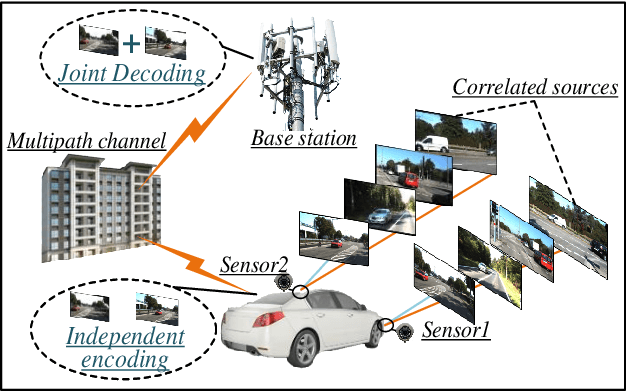
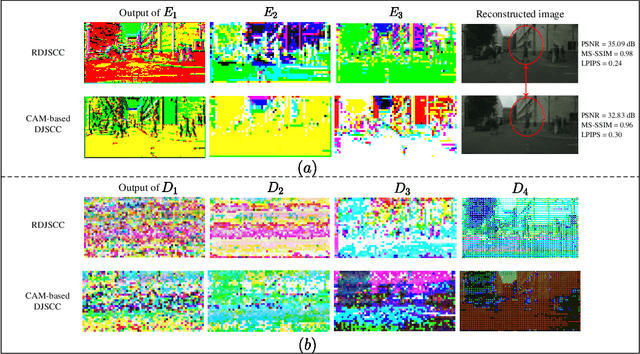
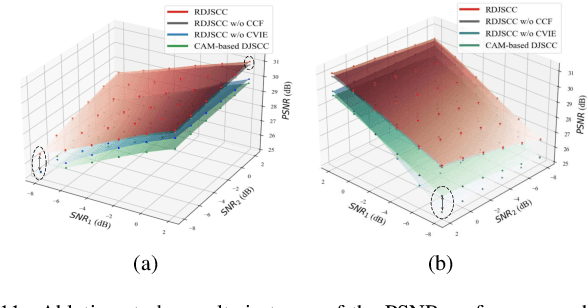
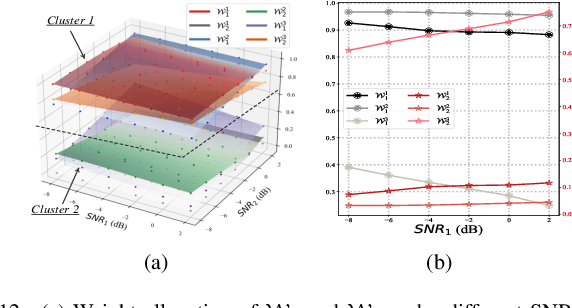
Abstract:This work is concerned with robust distributed multi-view image transmission over a severe fading channel with imperfect channel state information (CSI), wherein the sources are slightly correlated. Since the signals are further distorted at the decoder, traditional distributed deep joint source-channel coding (DJSCC) suffers considerable performance degradation. To tackle this problem, we leverage the complementarity and consistency characteristics among the distributed, yet correlated sources, and propose an enhanced robust DJSCC, namely RDJSCC. In RDJSCC, we design a novel cross-view information extraction (CVIE) mechanism to capture more nuanced cross-view patterns and dependencies. In addition, a complementarity-consistency fusion (CCF) mechanism is utilized to fuse the complementarity and consistency from multi-view information in a symmetric and compact manner. Theoretical analysis and simulation results show that our proposed RDJSCC can effectively leverage the advantages of correlated sources even under severe fading conditions, leading to an improved reconstruction performance. The open source code of this work is available at:https://dongbiao26.github.io/rdjscc/.
A Novel RFID Authentication Protocol Based on A Block-Order-Modulus Variable Matrix Encryption Algorithm
Dec 17, 2023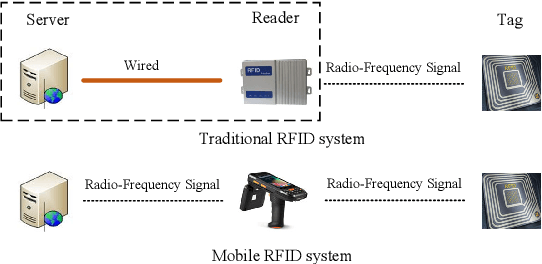
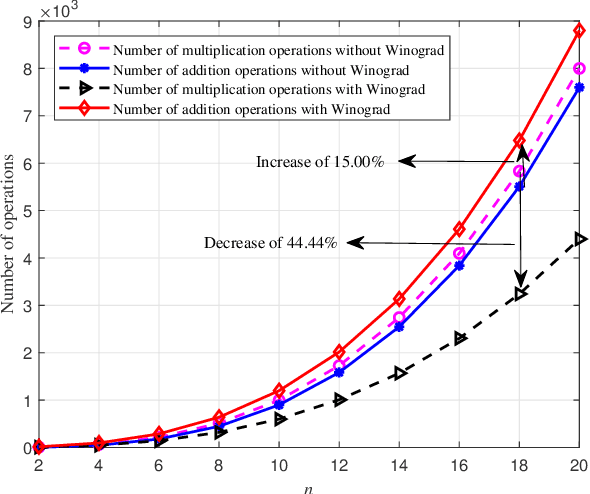
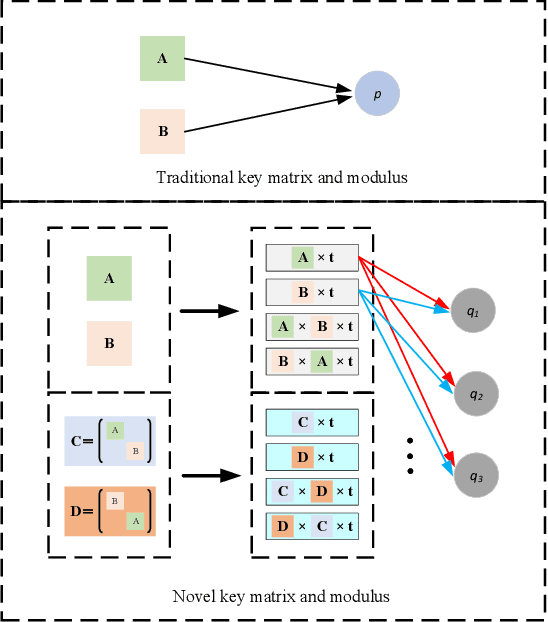

Abstract:In this paper, authentication for mobile radio frequency identification (RFID) systems with low-cost tags is studied. Firstly, a diagonal block key matrix (DBKM) encryption algorithm is proposed, which effectively expands the feasible domain of the key space. Subsequently, in order to enhance the security, a self updating encryption order (SUEO) algorithm is conceived. To further weaken the correlation between plaintext and ciphertext, a self updating modulus (SUM) algorithm is constructed. Based on the above three algorithms, a new joint DBKM-SUEO-SUM matrix encryption algorithm is established, which intends to enhance security without the need of additional storage for extra key matrices. Making full use of the advantages of the proposed joint algorithm, a two-way RFID authentication protocol named DBKM-SUEO-SUM-RFID is proposed for mobile RFID systems. In addition, the Burrows-Abadi-Needham (BAN) logic and security analysis indicate that the newly proposed DBKM-SUEO-SUM-RFID protocol can effectively resist various typical attacks, such as replay attacks and de-synchronization. Finally, numerical results demonstrate that the DBKM-SUEO-SUM algorithm can save at least 90.46\% of tag storage compared to traditional algorithms, and thus, is friendly to be employed with low-cost RFID tags.
Enhancing Sample Utilization through Sample Adaptive Augmentation in Semi-Supervised Learning
Sep 07, 2023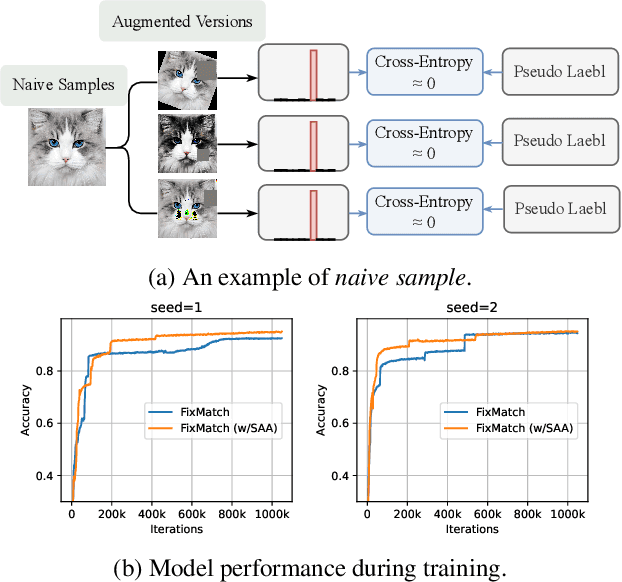


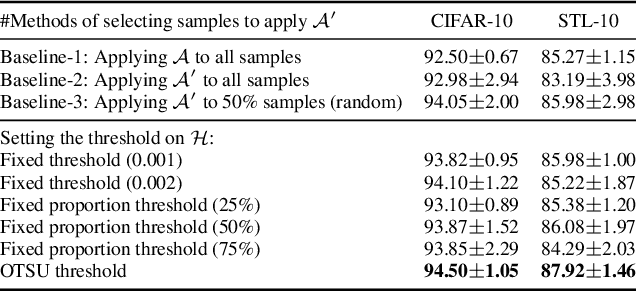
Abstract:In semi-supervised learning, unlabeled samples can be utilized through augmentation and consistency regularization. However, we observed certain samples, even undergoing strong augmentation, are still correctly classified with high confidence, resulting in a loss close to zero. It indicates that these samples have been already learned well and do not provide any additional optimization benefits to the model. We refer to these samples as ``naive samples". Unfortunately, existing SSL models overlook the characteristics of naive samples, and they just apply the same learning strategy to all samples. To further optimize the SSL model, we emphasize the importance of giving attention to naive samples and augmenting them in a more diverse manner. Sample adaptive augmentation (SAA) is proposed for this stated purpose and consists of two modules: 1) sample selection module; 2) sample augmentation module. Specifically, the sample selection module picks out {naive samples} based on historical training information at each epoch, then the naive samples will be augmented in a more diverse manner in the sample augmentation module. Thanks to the extreme ease of implementation of the above modules, SAA is advantageous for being simple and lightweight. We add SAA on top of FixMatch and FlexMatch respectively, and experiments demonstrate SAA can significantly improve the models. For example, SAA helped improve the accuracy of FixMatch from 92.50% to 94.76% and that of FlexMatch from 95.01% to 95.31% on CIFAR-10 with 40 labels.
* Accepted as International Conference on Computer Vision (ICCV) 2023
Rogue Emitter Detection Using Hybrid Network of Denoising Autoencoder and Deep Metric Learning
Dec 01, 2022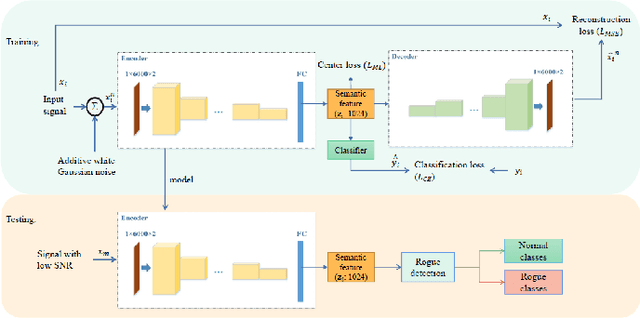
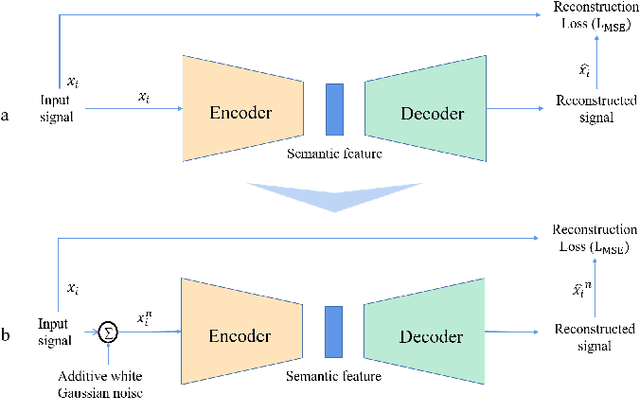
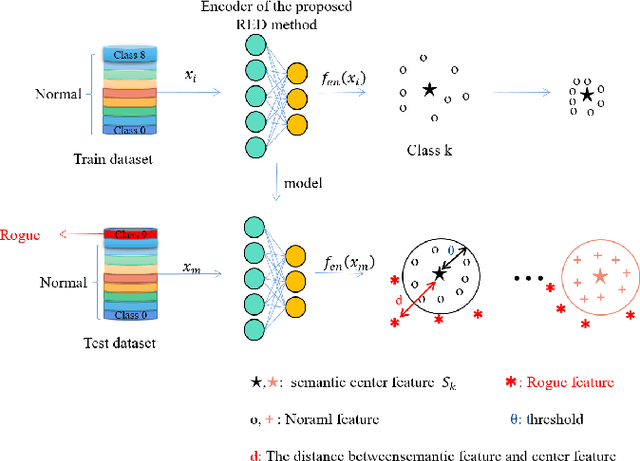
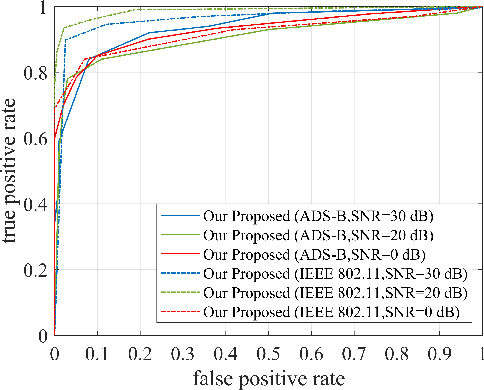
Abstract:Rogue emitter detection (RED) is a crucial technique to maintain secure internet of things applications. Existing deep learning-based RED methods have been proposed under the friendly environments. However, these methods perform unstable under low signal-to-noise ratio (SNR) scenarios. To address this problem, we propose a robust RED method, which is a hybrid network of denoising autoencoder and deep metric learning (DML). Specifically, denoising autoencoder is adopted to mitigate noise interference and then improve its robustness under low SNR while DML plays an important role to improve the feature discrimination. Several typical experiments are conducted to evaluate the proposed RED method on an automatic dependent surveillance-Broadcast dataset and an IEEE 802.11 dataset and also to compare it with existing RED methods. Simulation results show that the proposed method achieves better RED performance and higher noise robustness with more discriminative semantic vectors than existing methods.
 Add to Chrome
Add to Chrome Add to Firefox
Add to Firefox Add to Edge
Add to Edge